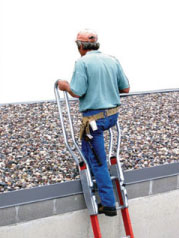- Standard Number:
OSHA requirements are set by statute, standards and regulations. Our interpretation letters explain these requirements and how they apply to particular circumstances, but they cannot create additional employer obligations. This letter constitutes OSHA's interpretation of the requirements discussed. Note that our enforcement guidance may be affected by changes to OSHA rules. Also, from time to time we update our guidance in response to new information. To keep apprised of such developments, you can consult OSHA's website at https://www.osha.gov.
December 22, 2005
Mr. Bruce Clark
President
American Innovations Corporation
1865 W. Wayzata Blvd.
Long Lake, MN 55356-9322
Re: Rail extensions for a portable ladder; step-through ladder device.
Dear Mr. Clark,
This is in response to your letter dated September 21, 2005 to the Occupational Safety and Health Administration (OSHA) in which you ask whether the walk-through railing system that you manufacture meets OSHA ladder safety requirements. Your letter was forwarded to this office for handling on September 26, 2005.
We have paraphrased your question as follows:
Question: American Innovations Corporation's Walk-Through Railing System ("Walk-Through") is an extension attached to a portable ladder. The device is designed to allow a person to walk through the top of a ladder onto a rooftop or landing, instead of having to step around the ladder. The Walk-Through consists of two components that attach over the top of each side rail of a portable ladder; see pictures below.


Section 1926.1053(b)(1) states that ladder side rails must extend at least 3 feet above the upper landing surface. The Walk-Through system is designed to be used as depicted in the picture above — the ladder's top rung is level with or slightly below the upper landing surface, the ladder's rails (in red in the picture) extend a few inches above the upper landing surface, and the top of the attached Walk-Through rail extensions are 3 feet above the upper landing surface. When so used, would an employer be in compliance with §1926.1053(b)(1)?
Answer: OSHA does not approve or endorse specific products. The variable working conditions at job sites and possible alteration or misapplication of an otherwise safe piece of equipment could easily create a hazardous condition beyond the control of the equipment manufacturer. However, where appropriate, we try to give some guidance to help employers assess whether products are appropriate to use in light of OSHA requirements.
29 CFR 1926.1053(b)(1) states:
When portable ladders are used for access to an upper landing surface, the ladder side rails shall extend at least 3 feet (.9 m) above the upper landing surface to which the ladder is used to gain access; or, when such an extension is not possible because of the ladder's length, then the ladder shall be secured at its top to a rigid support that will not deflect, and a grasping device, such as a grabrail, shall be provided to assist employees in mounting and dismounting the ladder. In no case shall the extension be such that ladder deflection under a load would, by itself, cause the ladder to slip off its support.
By its terms §1926.1053(b)(1) does not prohibit add-on ladder rail extensions or portable ladders designed with a step-through feature. For the purposes of this provision, rail extensions that are securely attached (that is, secured to the extent necessary to stabilize the extension and not expose the employee to a falling hazard from the extensions' displacement) would be considered part of the ladder itself. 1
Thus, a portable ladder with such extensions attached, and used as described above, would have its side rails extending at least 3 feet above the upper landing surface. Therefore, use of the ladder and the extensions in this manner would be in accordance with the 3-foot requirement in §1926.1053(b)(1).
While you referenced both General Industry (29 CFR Part 1910) and Construction Industry (Part 1926) provisions, this letter addresses only the ladder standard that is applicable to the construction industry. The general industry standard you cited, §1910.25(d)(2), does not apply to construction work; we have forwarded your letter to the Office of General Industry Enforcement for a response regarding those provisions.
If you need additional information, please contact us by fax at: U.S. Department of Labor, OSHA, Directorate of Construction, Office of Construction Standards and Guidance, fax #202-693-1689. You can also contact us by mail at the above office, Room N3468, 200 Constitution Avenue, N.W., Washington, D.C. 20210, although there will be a delay in our receiving correspondence by mail.
Sincerely,
Russell B. Swanson, Director
Directorate of Construction
1 As such, the portable ladder, with that extension, would still be subject to and must meet all applicable provisions in Subpart X - Stairways and Ladders. [ back to text ]

